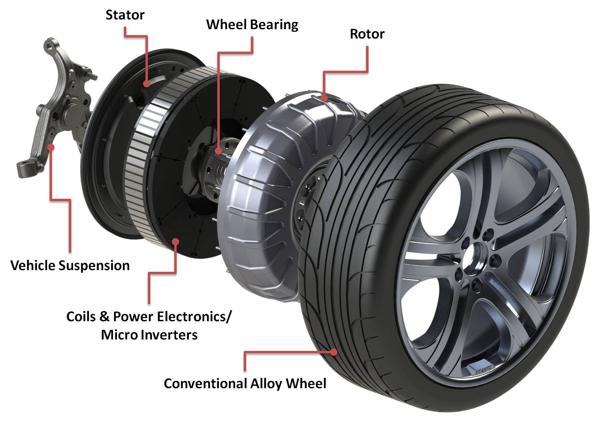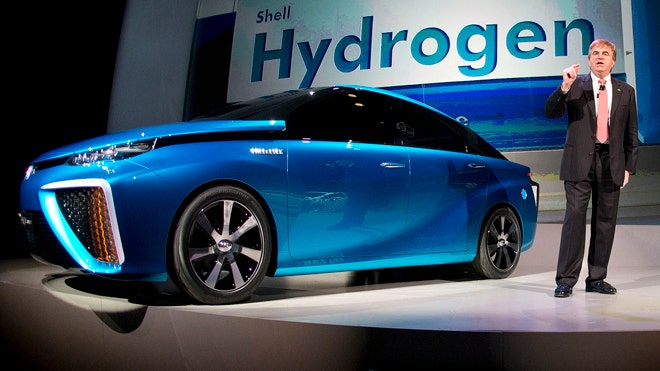Will This New Toyota Hydrogen Car Change the World?
If Toyota pulls this off, the decision for an efficient daily driver becomes a tossup between that and a Tesla.
My "mileage" are you referring to the vehicle's range on a full "charge" or the equivalent mileage per gallon? Refilling won't be too difficult. Telsa has engineered the Model S so that the battery pack can be swapped in less time than it takes to fill a conventional gasoline powered vehicle.
Tesla Model S - Battery Swap HD Official
And which electric car did you drive? Based on everything I've been reading, the Model S, and the soon to be released Model X, by Tesla, are pure adrenaline rushes.I drove an electric car once, It was the most boring thing ever
Ham Bone wrote:I drove a little car the dealership uses as a shuttle to and from buildings and across the street. It was drivable but I would never WANT to drive it.
The problem with battery's is that they wear out, who knows how soon? Surely as the recharges start to pile up the less life, or range, it will have.
And then when the battery is dead you have a hefty replacement cost and terrible battery juices for the environment.
I don't think that battery powered cars will be the future unless battery technology jumps rapidly in the near future, increasing the longevity of the battery. As it is I think they have batteries providing the range but the battery itself downs last long enough.
Do some reading on what Tesla has been doing with battery technology. The company applied for additional patents earlier this year.
There are different approaches to hydrogen fuel cells. One converts a small amount of fuel to hydrogen "on the fly", while another uses a storage tank.Wh1t3NuKle wrote:Hydrogen Cars F-these new vehicles. Yeah, even coming from me and the stuff I work on. I'd rather strap one of the solid rocket motors here on to a car b/c I know how it's gonna operate!!
Yes, I will admit it will be interesting to see how the Toyota's rendition of fuel cells rolls out. It's expected to be better than it's predecessors....which was by a GM company right? (I don't recall) The question is how will Toyota quell the public perception of Hydrogen sitting under your booty. I mean...we still have people thinking that nuclear power plants are just so bad....
Are you aware of a fuel cell design in which the chassis platform is constructed similar to a honeycomb? It is reported to be so safe that it cannot rupture, and in the event of a collision any force strong enough to break it will release minimal amounts of hydrogen. The cars and trucks you drive today are at a greater risk of starting a fire. The reason no one fears this is because these vehicles have been around for all of our lives.
Current electric cars
Battery packs are not like nuclear waste -- that's an apples to bowling balls comparison. The battery packs will be sent to reclamation facilities.-- really dislike them. Neighbor has a Volt, coworker has a smart car, other coworkers with volts and similar. All nice and dandy that the focus is on the clean exhaust emissions. Forget about what happens in terms of waste for these battery packs? yeah...we'll figure out when we get there like with nuclear waste, which has gone the way of storage pools and/or burying in various mountainous locations.
Too Quiet
These same kids don't hear today's cars coming down the street. Sorry, but that argument doesn't hold water.These electric cars suck donky in the realm of where kids play. Why? B/c you can't hear them! It can be very unexpected. This is my #1 gripe.
Driving Habits
That makes no sense.These cars also have meters that tell them how their driving with relationship b/t current speed and range. It's already bad enough that people make the passing lane a Sunday stroll, now you got it even worse with these cars doing the same thing!
Charging
Tesla has a supercharger network built along the west coast, from San Diego all the way to Seattle. In two years, there will be enough charging stations and battery replacement stations for someone to drive across the country.Apparently people with these cars, or the ones I've spoken to, don't think too much the impact of charging away from home either. They end up asking people to plug in at their house to charge up. Initially it's not really thought of as an issue b/c it's electricity. You can't see it to perceive it's actual cost. So now the car owner just bumped some gas money off their friend. Various stores now have charging stations placed nearest the doors. You do need a "Charge Card" LOL. Curious to know the rates since it's a prepaid card as far as I know. People at work here constantly have the 2 slots in use all the damn day. I will find out how that is working on payment/use/rotation/etc.
That is my input....thus far.
Either way, I stated that these would be for daily driving/commuter driving, which is what these vehicles are suited to do.
The three Teslas that caught fire did so only due to striking road debris with enough force that would have demolished a conventional vehicle. In the Washington and Tennessee events, the vehicle warned the driver of a problem and to pull over immediately.Wh1t3NuKle wrote:Tesla has indeed made great strides.
Everyone is watching how the recent battery fires are going to resolve. It's not unlike the new Boeing airplanes also didn't run into high technology battery problems that grounded the fleet earlier this year.
Patents are good, experimental data is better, and safety remains the final gate.
There is nothing in common as to the reason why the Tesla had battery fires with the Boeing.
Investigation reveals cause of battery fire on Boeing 787 Dreamliner







